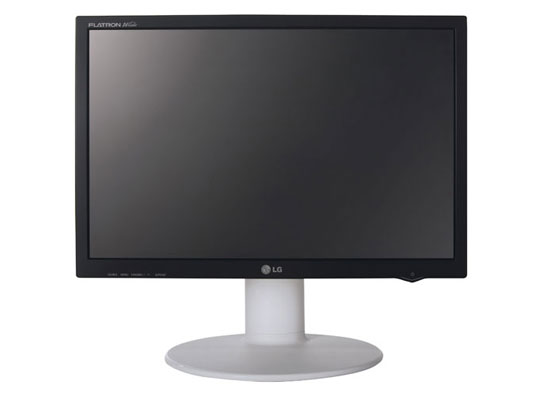LG Flatron L206WU - DisplayLink monitor
DisplayLink technology uses USB to expand your desktop view - no graphics card required! We check out the LG Flatron L206WU.

DisplayLink is an easy way of expanding your display environment, which will have great appeal to business and creative users. The LG Flatron L206WU itself is a mixed bag, however. While image quality is generally fine, the consumer styling won't suit businesses, you need an up-to-date system to get the best out of DisplayLink, and Linux users will have to miss out on the technology altogether.

The front at least is smart, but the shiny gloss bezel is more akin to LG's TV's than regular business screens. The power button is distinctive, a protruding curve with a button that needs a firm press to turn on - that glows blue when it's on and orange in standby.
At the rear you'll find VESA mounting points, and both DVI and VGA connections as well as the two USB ports, aside from the upstream port to hook up the DisplayLink connection. The stand, with a cable tidy at the rear, also has height adjustment, moving up or down in a smooth motion, and the screen pivots easily too, which can be very useful for looking at long web pages or documents.
However, doing this reveals one of the problems with the LG. The 22in, 1,680 x 1,050 screen is based on TN TFT technology, which is cheaper that IPS or S-PVA screens. One of its drawbacks is viewing angle. It's quoted as 170 degrees to the sides, which is probably stretching it in practice, but is at least acceptable. Vertically however, you'll find a change of shade as you move from the top to the bottom of the screen, which presents a problem when you turn the display on its side, as this shift now occurs from left to right, so making it harder to see both sides of your document or web page - not ideal. This proved so distracting that I could only work in this mode for around 10 minutes before switching back. As such it's useful as a reference tool, but you'll need to choose another option to work in portrait mode at length.
In general testing, when connected via USB, the first impression of the screen is that it's sharp and clear, as you would expect of the digital DisplayLink connection. The screen is rated at an average 300cd/m2 for brightness but the contrast ratio is given at 5,000:1, which is super high for a regular desktop monitor.
The reason for this is LG's F-Engine, which is designed to provide added punch and impact to images at the push of a button through the use of dynamic backlight adjustments and image processing. The neat part is that when you press the button you get a split screen effect, with it active on one side and not the other, enabling you to judge its effects.
Under our DisplayMate tests, the LG put in a decent performance with good colour reproduction. However, I wasn't too impressed with the effects of the various F-engine modes. In the colour scaling tests the movie mode boosted the brightness, but at the expense of too much compression at the top end, merging all the colours into one. In the text, it became too drab, so I found myself sticking to normal.
A bigger issue is that DisplayLink uses CPU power to help render the display. When testing on my Core2Duo powered system, the experience was smooth, whether moving windows for watching video. However, on an older Athlon XP system, it simply wasn't fast enough. Watching video from the BBC iPlayer was jerky, and even moving windows around was problematic.
All in all then the Displaylink technology does a good job, and is a great way of easily and quickly increasing your productivity. The caveats are that you need a reasonably powerful machine and a primarily static workload - think Excel spreadsheets and email, rather than intensive video editing. The display quality is generally good as is the range of adjustments but image quality in portrait mode is disappointing and while it looks stylish, it's might not be business-like enough for some offices.
Verdict
DisplayLink is an easy way of expanding your display environment, which will have great appeal to business and creative users. The LG Flatron L206WU itself is a mixed bag, however. While image quality is generally fine, the consumer styling won't suit businesses, you need an up-to-date system to get the best out of DisplayLink, and Linux users will have to miss out on the technology altogether.
Display Size: 22in
Resolution: 1,680 x 1,050
Display technology: TN
Brightness: 300 nits
Contrast Ratio: 5000:1 (claimed)
Response time: 2ms
Connections: DVI, D-Sub, 2x USB, DisplayLink
Adjustments: Tilt, height, pivot,
Dimensions (W x D x H): 471 x 271 x 420
Power consumption: 45W (max), 1W standby
Speakers: No
Security: Kensington lock
VESA mounting: Yes
Get the ITPro daily newsletter
Sign up today and you will receive a free copy of our Future Focus 2025 report - the leading guidance on AI, cybersecurity and other IT challenges as per 700+ senior executives
Benny Har-Even is a twenty-year stalwart of technology journalism who is passionate about all areas of the industry, but telecoms and mobile and home entertainment are among his chief interests. He has written for many of the leading tech publications in the UK, such as PC Pro and Wired, and previously held the position of technology editor at ITPro before regularly contributing as a freelancer.
Known affectionately as a ‘geek’ to his friends, his passion has seen him land opportunities to speak about technology on BBC television broadcasts, as well as a number of speaking engagements at industry events.
-
 CyberOne appoints Microsoft’s Tracey Pretorius to its advisory board
CyberOne appoints Microsoft’s Tracey Pretorius to its advisory boardNews The threat intelligence leader will provide strategic guidance to CyberOne’s executive team
By Daniel Todd Published
-
 CISA issues warning in wake of Oracle cloud credentials leak
CISA issues warning in wake of Oracle cloud credentials leakNews The security agency has published guidance for enterprises at risk
By Ross Kelly Published
-
 Reports: White House mulling DeepSeek ban amid investigation
Reports: White House mulling DeepSeek ban amid investigationNews Nvidia is caught up in US-China AI battle, but Huang still visits DeepSeek in Beijing
By Nicole Kobie Published